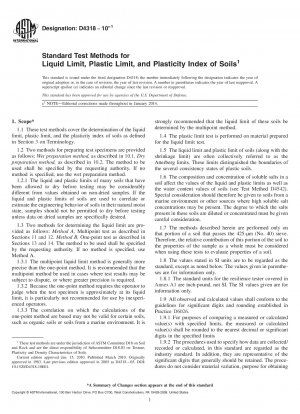ASTM D4318-10e1
Standard Test Methods for Liquid Limit, Plastic Limit, and Plasticity Index of Soils
- Standard No.
- ASTM D4318-10e1
- Release Date
- 2010
- Published By
- American Society for Testing and Materials (ASTM)
- Status
- Replace By
- ASTM D4318-17
- Latest
- ASTM D4318-17e1
- Scope
5.1 These test methods are used as an integral part of several engineering classification systems to characterize the fine-grained fractions of soils (see Practices D2487 and D3282) and to specify the fine-grained fraction of construction materials (see Specification D1241). The liquid limit, plastic limit, and plasticity index of soils are also used extensively, either individually or together, with other soil properties to correlate with engineering behavior such as compressibility, hydraulic conductivity (permeability), compactibility, shrink-swell, and shear strength.
5.2 The liquid and plastic limits of a soil and its water content can be used to express its relative consistency or liquidity index. In addition, the plasticity index and the percentage finer than 2-μm particle size can be used to determine its activity number.
5.3 These methods are sometimes used to evaluate the weathering characteristics of clay-shale materials. When subjected to repeated wetting and drying cycles, the liquid limits of these materials tend to increase. The amount of increase is considered to be a measure of a shale's susceptibility to weathering.
5.4 The liquid limit of a soil containing substantial amounts of organic matter decreases dramatically when the soil is oven-dried before testing. Comparison of the liquid limit of a sample before and after oven-drying can therefore be used as a qualitative measure of organic matter content of a soil (see Practice D2487.
Note 1—The quality of the result produced by this standard is dependent on the competence of the personnel performing it and the suitability of the equipment and facilities used. Agencies that meet the criteria of Practice D3740, generally, are considered capable of competent and objective testing/sampling/inspection/etc. Users of this standard are cautioned that compliance with Practice D3740 does not in itself assure reliable results. Reliable results depend on many factors; Practice D3740 provides a means of evaluating some of those factors.1.1 These test methods cover the determination of the liquid limit, plastic limit, and the plasticity index of soils as defined in Section 3 on Terminology.
1.2 Two methods for preparing test specimens are provided as follows: Wet preparation method, as described in 10.1. Dry preparation method, as described in 10.2. The method to be used shall be specified by the requesting authority. If no method is specified, use the wet preparation method.
1.2.1 The liquid and plastic limits of many soils that have been allowed to dry before testing may be considerably different from values obtained on non-dried samples. If the liquid and plastic limits of soils are used to correlate or estimate the engineering behavior of soils in their natural moist state, samples should not be permitted to dry before testing unless data on dried samples are specifically desired.
1.3 Two methods for determining the liquid limit are provided as follows: Method A, Multipoint test as described in Sections 11 and
ASTM D4318-10e1 Referenced Document
- ASTM C702 Standard Practice for Reducing Samples of Aggregate to Testing Size
- ASTM D1241 Standard Specification for Materials for Soil-Aggregate Subbase, Base, and Surface Courses
- ASTM D2216 Standard Test Method for Laboratory Determination of Water (Moisture) Content of Soil and Rock by Mass
- ASTM D2487 Standard Test Method for Classification Of Soils For Engineering Purposes
- ASTM D3282 Standard Practice for Classification of Soils and Soil-Aggregate Mixtures for Highway Construction Purposes
- ASTM D3740 Standard Practice for Minimum Requirements for Agencies Engaged in the Testing and/or Inspection of Soil and Rock as Used in Engineering Design and Construction
- ASTM D420 Standard Guide to Site Characterization for Engineering Design and Construction Purposes
- ASTM D4542 Standard Test Method for Pore Water Extraction and Determination of the Soluble Salt Content of Soils by Refractometer
- ASTM D4753 Standard Specification for Evaluating, Selecting, and Specifying Balances and Scales for Use in Soil, Rock, and Construction Materials Testing
- ASTM D6026 Standard Practice for Using Significant Digits in Geotechnical Data
- ASTM D653 Standard Terminology Relating to Soil, Rock, and Contained Fluids
- ASTM D75 Standard Practice for Sampling Aggregates
- ASTM E11 Standard Specification for Wire Cloth and Sieves for Testing Purposes
- ASTM E177 Standard Practice for Use of the Terms Precision and Bias in ASTM Test Methods
- ASTM E691 Standard Practice for Conducting an Interlaboratory Study to Determine the Precision of a Test Method
ASTM D4318-10e1 history
- 2017 ASTM D4318-17e1 Standard Test Methods for Liquid Limit, Plastic Limit, and Plasticity Index of Soils
- 2017 ASTM D4318-17 Standard Test Methods for Liquid Limit, Plastic Limit, and Plasticity Index of Soils
- 2010 ASTM D4318-10e1 Standard Test Methods for Liquid Limit, Plastic Limit, and Plasticity Index of Soils
- 2010 ASTM D4318-10 Standard Test Methods for Liquid Limit, Plastic Limit, and Plasticity Index of Soils
- 2005 ASTM D4318-05 Standard Test Methods for Liquid Limit, Plastic Limit, and Plasticity Index of Soils
- 2000 ASTM D4318-00 Standard Test Methods for Liquid Limit, Plastic Limit, and Plasticity Index of Soils

Copyright ©2024 All Rights Reserved